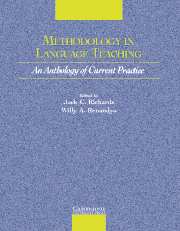Book contents
- Frontmatter
- Contents
- Acknowledgments
- Introduction
- Section I Approaches to Teaching
- Section 2 Lesson Planning and Classroom Management
- Section 3 Classroom Dynamics
- Section 4 Syllabus Design and Instructional Materials
- Section 5 Task and Project Work
- Section 6 Learning Strategies
- Section 7 Teaching Grammar
- Section 8 Teaching Pronunciation
- Section 9 Teaching Speaking
- Section 10 Teaching Listening
- Section 11 Teaching Vocabulary
- Section 12 Teaching Reading
- Section 13 Teaching Writing
- Section 14 Assessment
- Section 15 Technologies in the Classroom
- Section 16 Professional Development
- Credits
- Author Index
- Subject Index
Section 13 - Teaching Writing
Published online by Cambridge University Press: 10 November 2010
- Frontmatter
- Contents
- Acknowledgments
- Introduction
- Section I Approaches to Teaching
- Section 2 Lesson Planning and Classroom Management
- Section 3 Classroom Dynamics
- Section 4 Syllabus Design and Instructional Materials
- Section 5 Task and Project Work
- Section 6 Learning Strategies
- Section 7 Teaching Grammar
- Section 8 Teaching Pronunciation
- Section 9 Teaching Speaking
- Section 10 Teaching Listening
- Section 11 Teaching Vocabulary
- Section 12 Teaching Reading
- Section 13 Teaching Writing
- Section 14 Assessment
- Section 15 Technologies in the Classroom
- Section 16 Professional Development
- Credits
- Author Index
- Subject Index
Summary
INTRODUCTION
There is no doubt that writing is the most difficult skill for L2 learners to master. The difficulty lies not only in generating and organizing ideas, but also in translating these ideas into readable text. The skills involved in writing are highly complex. L2 writers have to pay attention to higher level skills of planning and organizing as well as lower level skills of spelling, punctuation, word choice, and so on. The difficulty becomes even more pronounced if their language proficiency is weak.
With so many conflicting theories around and so many implementation factors to consider, planning and teaching a course in writing can be a daunting task. Which theoretical strands are we going to adopt? Are we going to use the process approach or the genre-based approach? Or an eclectic approach? What will be the focus of our course? What activities are likely to help students develop their writing skills? How do we treat learner errors? Do we correct all error types? How do we get students to self-edit? These are some of the issues that the four articles in this section seek to address.
Drawing on her extensive experience in research and teaching writing, Raimes outlines a set of guidelines which can make the planning of a writing course a less intimidating task. These guidelines are based on what we have long known to be the key principles of course design, which include considerations of course goals, theories, content, focus, syllabus, materials, methodology, activities, and course evaluation.
- Type
- Chapter
- Information
- Methodology in Language TeachingAn Anthology of Current Practice, pp. 303 - 305Publisher: Cambridge University PressPrint publication year: 2002
- 1
- Cited by

